Discover the timeless beauty of traditional Maharashtrian jewellery pieces that every connoisseur should know about.
From intricate gold necklaces to stunning diamond and ruby noserings, these vintage Maharashtrian jewellery designs are perfect for your wedding trousseau!
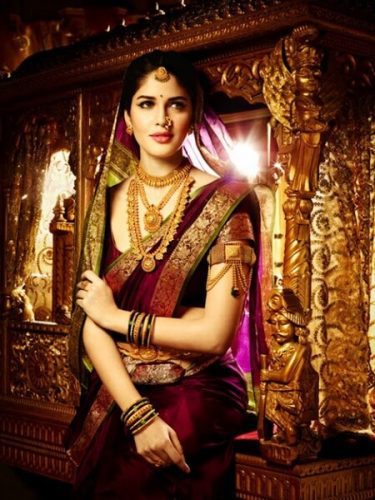
Maharashtra is renowned for its rich cultural heritage, and its traditional jewellery is a testament to this vibrant and diverse culture. From intricate gold necklaces to stunning diamond-studded bangles, Maharashtrian jewellery showcases the region’s artistry, craftsmanship, and traditions.
Each piece tells a unique story and holds a special place in the hearts of those who wear them. This article explores the exquisite traditional jewellery of Maharashtra, unveiling the secrets of its design, symbolism, and cultural significance.
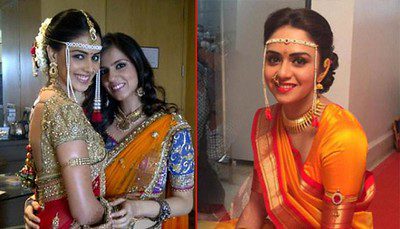
Gold jewellery has been an integral part of Maharashtrian culture for centuries. Most traditional Maharashtrian gold jewellery worn by women today is inspired by the pieces adorned by the Peshwas and Marathas.
To complete the classic look of a Maharashtrian woman, jewellery is essential. Whether paired with a Paithani saree or a Chandrakor bindi, traditional jewellery adds the perfect finishing touch. For those unfamiliar with Maharashtrian culture, choosing the right pieces can be challenging. It’s essential to select the correct jewellery to truly embody the typical Maharashtrian woman and slay in style.
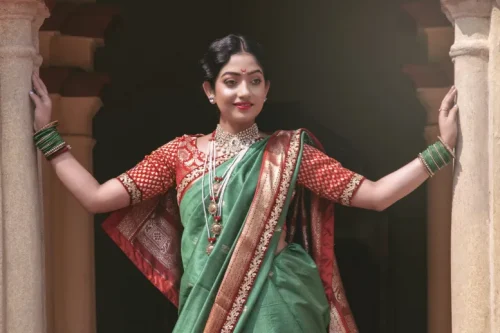
To help you achieve the perfect Marathi ‘mulgi’ look, we’ve curated a list of traditional Maharashtrian jewellery pieces. This guide will help you understand the culture and select the right jewellery to rock the Marathi style confidently.
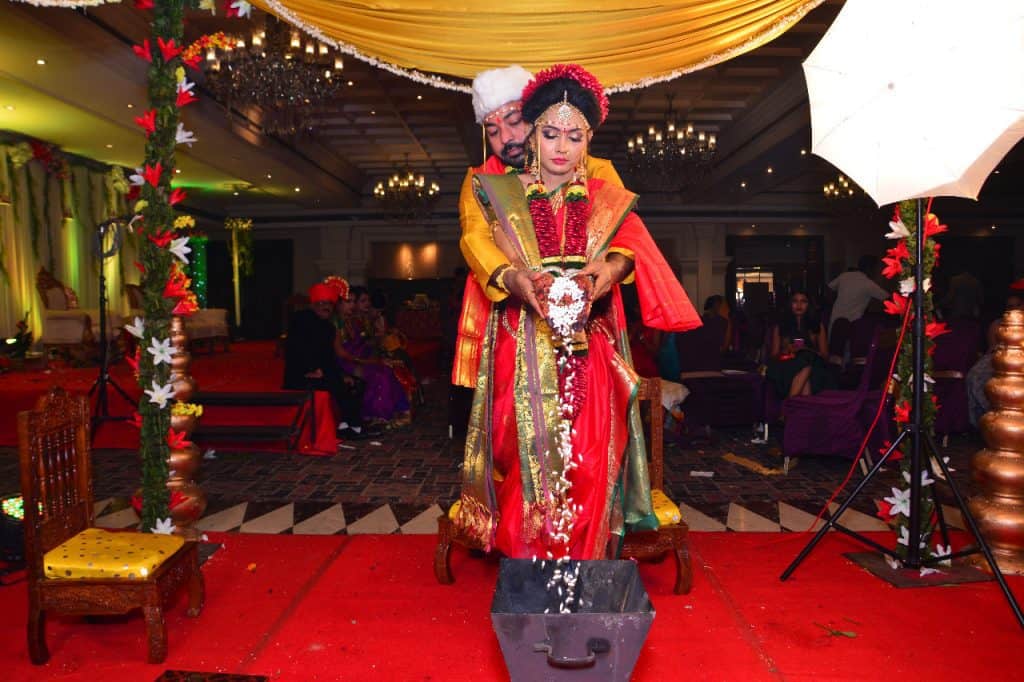
The Iconic Pieces of Maharashtrian Jewellery
Brahmani Nath (Nose Ring)
The Nath, a quintessential piece of Maharashtrian jewellery, holds a special place in every traditional ensemble. Among its various designs, the Brahmani Nath stands out for its intricate craftsmanship and the use of precious gemstones like diamonds, rubies, and emeralds. Named after the Hindu goddess Brahmani, who symbolizes power and wisdom, this Nath is more than just an accessory—it’s a symbol of femininity, elegance, and prosperity.
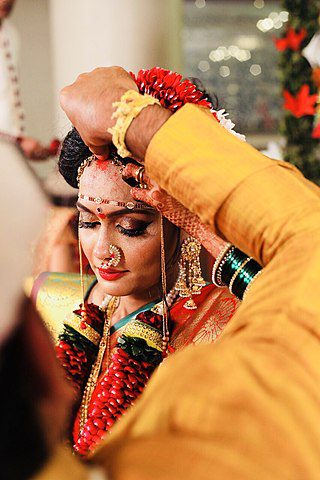
Traditionally worn by women during special occasions such as poojas and weddings, the Maharashtrian Nath is handwoven with pearls and features stunning white and pink stones in the centre. Its unique design sets it apart from other nose pins, adding a distinct touch to the traditional look of Maharashtrian women.
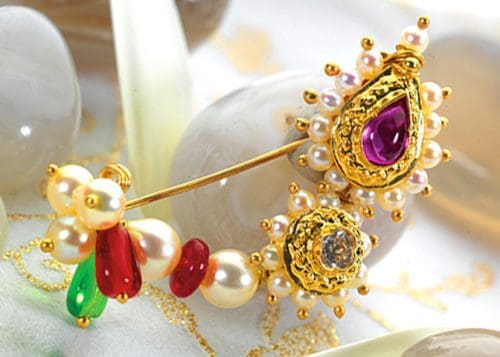
Whether you’re attending a grand wedding or a festive celebration, the Nath completes the traditional attire, making it an indispensable part of Maharashtrian culture and fashion.
Kolhapuri Thushi
Kolhapuri Thushi is a traditional Indian jewellery piece that hails from the Kolhapur region of Maharashtra. The term “Thushi” translates to “small gold beads” in Marathi, which perfectly describes this exquisite necklace.
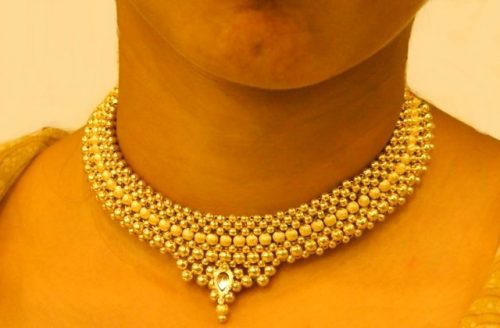
Made of multiple strands of small gold beads woven together using a special technique, the Kolhapuri Thushi typically rests on the collarbone and often features a central pendant or a cluster of beads.
Thushi is a choker-style necklace that makes every Maharashtrian bride shine. Originating from Kolhapur, this stunning piece is crafted from 22-karat pure gold.
Featuring gold beads of various sizes intricately woven together, Thushi forms layers with a mesh of strings. The necklace also comes with an adjustable dori, allowing you to customize the fit perfectly to your neck size.
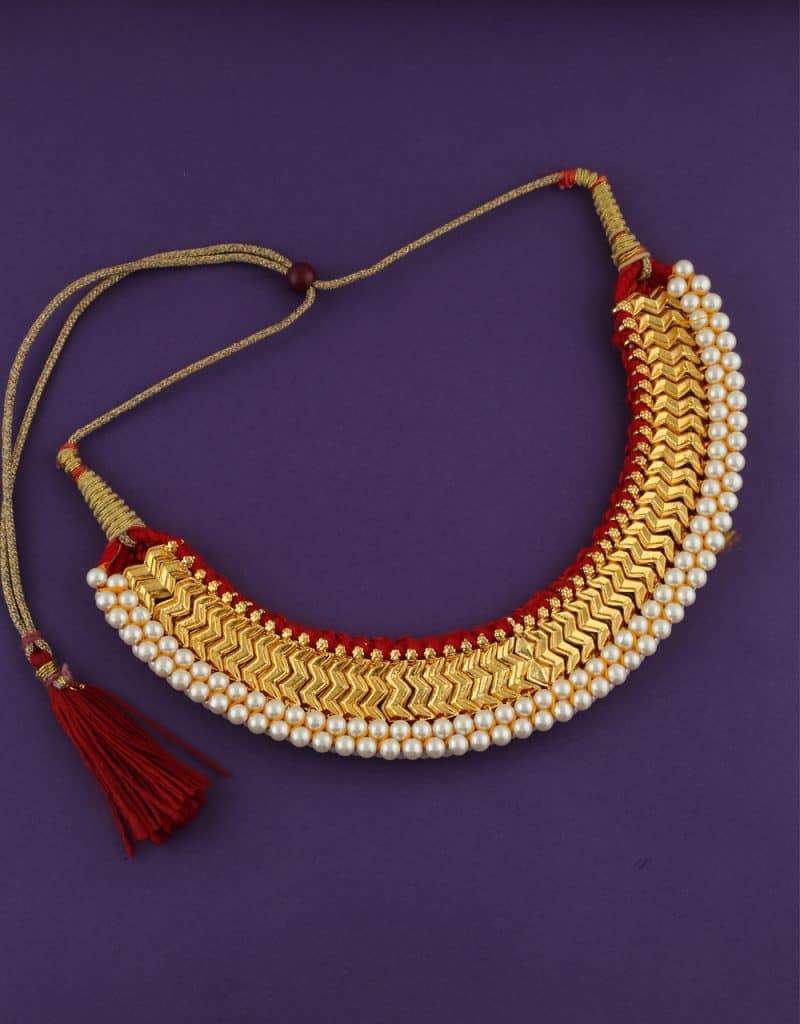
Kolhapuri Saaz (Necklace)
Kolhapuri Saaj is a traditional Indian jewellery piece from the Kolhapur region of Maharashtra. This necklace features multiple chains, each adorned with unique designs and gemstones like pearls, rubies, and emeralds. The centrepiece is typically a large pendant crafted with intricate designs and embellishments. Often paired with matching earrings, the Kolhapuri Saaj is a crucial part of a Maharashtrian bride’s trousseau.
Made from 22-carat gold, it is renowned for its exquisite craftsmanship and intricate design. This necklace symbolizes tradition, beauty, and elegance, and is worn on special occasions such as weddings, festivals, and other cultural events. With its unique design and cultural significance, Kolhapuri Saaj remains a treasured piece of jewellery, essential in traditional Indian fashion.
The central pendant, known as the ‘saaj ghat,’ features 21 leaves. Ten of these represent the ten different avatars of Lord Vishnu, two contain emerald and ruby stones, eight symbolize ashtanga (auspiciousness, happiness, and prosperity), and the last pendant, the Taviz, is a charm believed to ward off evil.
Mohan Mala (Beaded Necklace)
Mohan Mala is a sophisticated necklace made from gold beads, often designed with simple beads strung on a single thread. It can be layered to create a more elaborate and fancy appearance.
Mohan Mala, a type of traditional Indian jewellery, originates from Rajasthan and Maharashtra. The word “Mohan” means charming or attractive, and “Mala” refers to a necklace. True to its name, Mohan Mala is a stunningly beautiful necklace crafted from precious metals like gold and silver, and adorned with exquisite gemstones such as rubies, emeralds, diamonds, and sapphires.
It consists of multiple strands of beads or pearls, often held together by an ornate centrepiece featuring designs like peacocks, elephants, or floral motifs. Mohan Mala is typically worn by women during weddings, festive occasions, and other cultural events, symbolizing beauty, elegance, and tradition.
Bugadi (Ear Cuffs)
The term “Bugudi” refers to a cluster, while “Koppu” likely comes from the Tamil word “krambu(ch),” meaning clove stick. This is one of the most beautiful pieces of Maharashtrian ear jewellery.
Bugadi is worn by Maharashtrian women specifically on the helix part of the ear. Its basic design is a thin, long, hollow plug with a screw, secured by small balls at both ends. It typically features silver granules with pearls or beads hanging. This jewellery is primarily worn by traditional Hindu communities in Maharashtra, Karnataka, and Tamil Nadu.
Jodvi (Toe Rings)
Jodvi is a traditional Indian jewellery piece worn on the feet. Originating in Rajasthan, it is also a significant accessory for Maharashtrian women and is typically made of silver or gold. Worn during weddings and festive occasions, Jodvi adds beauty and grace to the overall attire.
Its design ranges from simple to intricate, often adorned with gemstones or embellished with detailed patterns. The jewellery piece consists of a band around the ankle and a chain or string of beads that extends to the toe. Jodvi not only enhances the beauty of a woman’s feet but also offers therapeutic benefits by improving blood circulation and reducing swelling.
Tode is the Maharashtrian version of a gold bangle. These bangles are intricately carved with various motifs, typically weighing around 250-300 grams each.
Tode (Bangles)
Completely handmade, Tode bangles are intricately interlinked, a process that takes about a month to complete. Known for being one of the heaviest bangles worn by a Maharashtrian bride, Tode are thick kadas interlinked without any soldering. They are usually worn at the beginning or middle of the traditional green chuda worn by brides.
Vaaki (Armlet)
Vaaki, also known as a bajuband or armlet, is an exquisite piece of jewellery made entirely of gold, featuring a prominent precious stone like an emerald or ruby at its centre, and adorned with delicate gold chains. Traditionally worn on both arms, modern trends have seen Maharashtrian women wearing it on a single arm.
Kaan (earpiece)
Kaan is a traditional Indian earring worn by women in Maharashtra. Designed to adorn both the earlobe and the outer part of the ear, Kaan features intricate designs often incorporating precious gemstones like diamonds, rubies, and emeralds. This jewellery piece is essential for a Maharashtrian bride’s trousseau and is also worn during festivals and weddings.
Typically made of gold or silver, Kaan stands out with its detailed craftsmanship. Its design can range from simple to elaborate and is often customized to match a woman’s personal style. With its unique design and cultural significance, Kaan is a cherished piece of jewellery that enhances the beauty and elegance of traditional Indian fashion.
Ambada (Hair Accessory)
Ambada is a hair accessory crafted to secure a woman’s hair in a bun or chignon. It typically features a gold or silver base adorned with intricate designs, embellishments, and gemstones such as diamonds, rubies, and emeralds. Often passed down through generations as a family heirloom, Ambada is a crucial part of a Maharashtrian bride’s trousseau. It symbolizes elegance, beauty, marital status, and prosperity.
The design of Ambada can range from simple to elaborate and is often customized to match a woman’s personal style. With its unique design and cultural significance, Ambada remains a cherished piece of jewellery, integral to traditional Indian fashion.
Chooda
Chooda refers to a set of green bangles worn by Maharashtrian brides. Unlike the red chooda of North Indian brides, these green bangles symbolize fertility and prosperity.
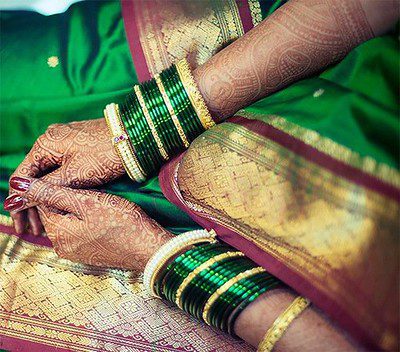
They are worn on both hands in odd numbers and are made of glass. These bangles are not removed until some time after the marriage.
Kamarband (Waistband)
Traditionally known as kambarpatta in Maharashtra, this gold belt is worn by the bride to cinch her waist. Available in various designs and made from different metals, it adds an elegant touch to the bridal attire.
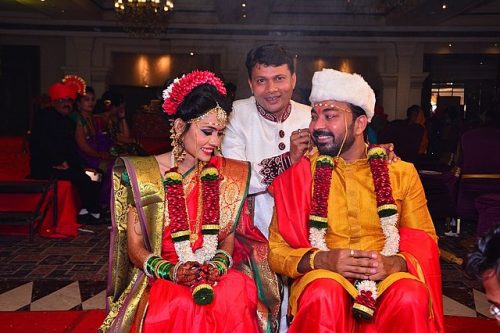
Whether you are a connoisseur of fine jewellery or simply appreciate the beauty of traditional craftsmanship, Maharashtrian jewellery offers a dazzling array of options that are both timeless and captivating. From the iconic Nath to the regal Vaaki, each piece is a work of art that reflects the traditions and values of Maharashtra. Embrace the elegance and charm of Maharashtrian jewellery, and let it add a touch of heritage and glamour to your collection.
Read more: Latest



